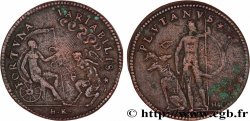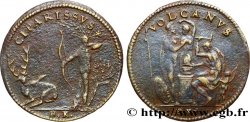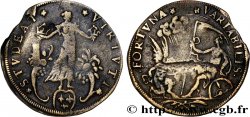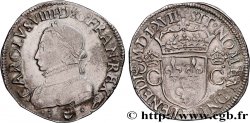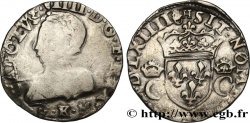Live auction - bry_830176 - CHARLES IX Demi-écu d'or au soleil du Dauphiné 1566 Grenoble
You must signin and be an approved bidder to bid, LOGIN TO BID. Accounts are subject to approval and the approval process takes place within 48 hours. Do not wait until the day a sale closes to register. Clicking on "BID" constitutes acceptance of the terms of use of cgb.fr private live auctions.
Bids must be placed in whole Euro amounts only. The sale will start closing at the time stated on the item description; any bids received at the site after the closing time will not be executed. Transmission times may vary and bids could be rejected if you wait until the last second. For further information check the Live auction FAQ
All winning bids are subject to a 18% buyer’s fee.
All winning bids are subject to a 18% buyer’s fee.
| Estimate : | 100 000 € |
| Price : | 46 000 € |
| Maximum bid : | 46 000 € |
| End of the sale : | 06 June 2023 17:42:27 |
| bidders : | 6 bidders |
Type : Demi-écu d'or au soleil du Dauphiné
Date: 1566
Mint name / Town : Grenoble
Quantity minted : 2800
Metal : gold
Millesimal fineness : 958 ‰
Diameter : 22 mm
Orientation dies : 6 h.
Weight : 1,68 g.
Rarity : UNIQUE
Coments on the condition:
Ce demi-écu d’or est frappé sur un flan large et légèrement irrégulier. Monnaie de toute beauté, avec son brillant et son coupant de frappe. Petite faiblesse de frappe à 5 heures au droit. Monnaie pour laquelle nous avons hésité à mettre SPL
Catalogue references :
Predigree :
Avec son certificat d'exportation de bien culturel n°225227 délivré par le ministère français de la Culture
Obverse
Obverse legend : (SOLEIL À SIX RAYONS) CAROLVS. 9. DEI G. FRANCOR. REX. (MM).
Obverse description : Écu couronné, écartelé aux 1 et 4 de France, aux 2 et 3 de Dauphiné.
Obverse translation : (Charles IX, par la grâce de Dieu, roi des Francs).
Reverse
Reverse legend : (ROSE) XPS. VINCIT. XPS REGNAT. XPS. IN. 1566. (MM).
Reverse description : Croix fleurdelisée avec un losange incurvé en cœur contenant la lettre d'atelier (Z).
Reverse translation : (Le Christ vainc, règne et commande).
Commentary
Demi-écu d’or ayant fait l’objet d’un article dans le Bulletin Numismatique du mois de mai 2023, dont nous reprenons quelques éléments :
Une monnaie d’exception enfin retrouvée : le demi-écu d’or du Dauphiné de Charles IX (Grenoble, 1566).
En 1956, Jean Lafaurie et Pierre Prieur mentionnaient l’existence d’un demi-écu d’or de Charles IX pour le Dauphiné, cette monnaie restant à retrouver. La notice n° 894, p. 83, de leur ouvrage indiquait :
« Demi-écu d’or du Dauphiné. Même description. Poids légal 1 gr. 68. Atelier Grenoble. Il a été frappé, au moins en 1566, des Demi-écus d’or au type delphinal ; aucun exemplaire n’a été retrouvé ».
Depuis 1956, aucun demi-écu d’or n’avait été retrouvé et cette pièce est l’une des plus rares – si ce n’est la plus rare – du règne de Charles IX.
Le différent d’atelier de Grenoble, la lettre Z, est présent en cœur de la croix du revers et est complété par une rose située du même côté, en début de légende. Le différent du maître Pierre De Luan, en exercice de 1556 à 1567, est constitué par la lettre D placée en fin des légendes.
Le type de cette monnaie est en tout point similaire à l’écu d’or (Figure 2) avec toutefois une absence de point secret sous la troisième lettre de la légende du droit. Hormis ce petit détail, seuls le poids et le diamètre permettent de distinguer l’écu d’or du demi-écu.
Comment connaissait-on l’existence de cette monnaie sans jamais l’avoir retrouvée ?
Les registres des délivrances ou les états annuels récapitulatifs des productions des années 1560 ne sont pas conservés pour Grenoble. Il existe toutefois deux registres conservés aux Archives nationales, celui notant l’apport des boîtes des monnaies du royaume au greffe de la Cour des monnaies (AN, Z1b 296, f° 11 v°) (Figure 3) et le registre dit du contrôle de la recette générale des boîtes (AN, Z1b 301, f° 105) (Figure 4). Ces deux registres, indiquent que la boîte de l’année 1566 de la Monnaie de Grenoble contenait notamment 11,5 écus d’or, donc des demi-écus. C’est sur la base de ces deux registres que Pierre Prieur, qui a fait les recherches et dépouillements en archives pour le « Lafaurie/Prieur », a pu supposer l’existence de cette monnaie. La boîte de l’année 1566 de la Monnaie de Grenoble a été apportée au greffe de la Cour des monnaies le 16 mai 1567 et elle fut ouverte le premier juillet suivant.
Pour les années 1562-1563, 1565-1569, 1573 et 1574, des frappes d’écus d’or du Dauphiné sont bien attestées à Grenoble, toutefois, hormis 1566, les autres chiffres de mise en boîte tombant justes, nous ne pouvons pas affirmer que des demi-écus d’or aient été frappés à d’autres millésimes que 1566. Le chiffre de frappe en écus se situe autour de 2300 exemplaires, en suivant la règle de mise en boîte d’un écu d’or mis en boîte pour 200 délivrés. Ce chiffre, assez faible, comprend une faible quantité de demi-écus d’or
.
Une monnaie d’exception enfin retrouvée : le demi-écu d’or du Dauphiné de Charles IX (Grenoble, 1566).
En 1956, Jean Lafaurie et Pierre Prieur mentionnaient l’existence d’un demi-écu d’or de Charles IX pour le Dauphiné, cette monnaie restant à retrouver. La notice n° 894, p. 83, de leur ouvrage indiquait :
« Demi-écu d’or du Dauphiné. Même description. Poids légal 1 gr. 68. Atelier Grenoble. Il a été frappé, au moins en 1566, des Demi-écus d’or au type delphinal ; aucun exemplaire n’a été retrouvé ».
Depuis 1956, aucun demi-écu d’or n’avait été retrouvé et cette pièce est l’une des plus rares – si ce n’est la plus rare – du règne de Charles IX.
Le différent d’atelier de Grenoble, la lettre Z, est présent en cœur de la croix du revers et est complété par une rose située du même côté, en début de légende. Le différent du maître Pierre De Luan, en exercice de 1556 à 1567, est constitué par la lettre D placée en fin des légendes.
Le type de cette monnaie est en tout point similaire à l’écu d’or (Figure 2) avec toutefois une absence de point secret sous la troisième lettre de la légende du droit. Hormis ce petit détail, seuls le poids et le diamètre permettent de distinguer l’écu d’or du demi-écu.
Comment connaissait-on l’existence de cette monnaie sans jamais l’avoir retrouvée ?
Les registres des délivrances ou les états annuels récapitulatifs des productions des années 1560 ne sont pas conservés pour Grenoble. Il existe toutefois deux registres conservés aux Archives nationales, celui notant l’apport des boîtes des monnaies du royaume au greffe de la Cour des monnaies (AN, Z1b 296, f° 11 v°) (Figure 3) et le registre dit du contrôle de la recette générale des boîtes (AN, Z1b 301, f° 105) (Figure 4). Ces deux registres, indiquent que la boîte de l’année 1566 de la Monnaie de Grenoble contenait notamment 11,5 écus d’or, donc des demi-écus. C’est sur la base de ces deux registres que Pierre Prieur, qui a fait les recherches et dépouillements en archives pour le « Lafaurie/Prieur », a pu supposer l’existence de cette monnaie. La boîte de l’année 1566 de la Monnaie de Grenoble a été apportée au greffe de la Cour des monnaies le 16 mai 1567 et elle fut ouverte le premier juillet suivant.
Pour les années 1562-1563, 1565-1569, 1573 et 1574, des frappes d’écus d’or du Dauphiné sont bien attestées à Grenoble, toutefois, hormis 1566, les autres chiffres de mise en boîte tombant justes, nous ne pouvons pas affirmer que des demi-écus d’or aient été frappés à d’autres millésimes que 1566. Le chiffre de frappe en écus se situe autour de 2300 exemplaires, en suivant la règle de mise en boîte d’un écu d’or mis en boîte pour 200 délivrés. Ce chiffre, assez faible, comprend une faible quantité de demi-écus d’or
.








 Report a mistake
Report a mistake Print the page
Print the page Share my selection
Share my selection Ask a question
Ask a question Consign / sell
Consign / sell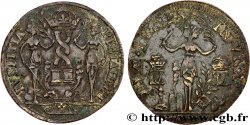
 Full data
Full data